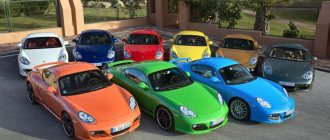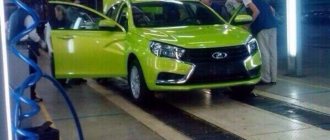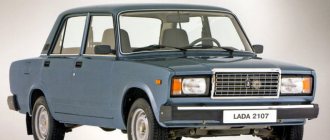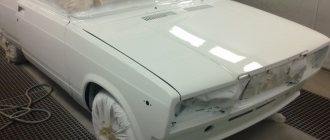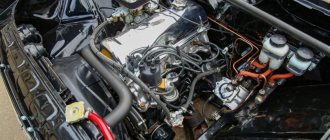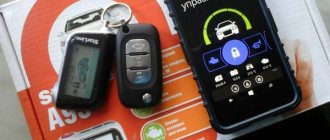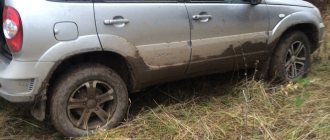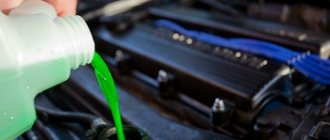The seventh model of the Volzhsky Automobile Plant is included in the segment of the so-called luxury cars of the enterprise. However, unlike the fast and somewhat defiant “Six”, it is focused on a different audience - those who value not only good driving properties, but also functionality. The optimal balance of performance properties allowed the domestic sedan to carve out its niche in the market and go down in history forever.
The history of the VAZ 2107 begins in 1977 - when the first copies of this model went for testing. Serial production of the car began only five years later - in 1982. At that time, the “Seven” was the most advanced model, which was part of the “Zhiguli” family.
Even compared to the Lada 2106, the new product looked more refined from a technical point of view, and besides, the engineers were able to get rid of many solutions that were unacceptable for the “classic”.
What is the difference between VAZ 2105 and VAZ 2107
The seventh model is a luxury version of the Five and has the following main differences:
- A more monumental and larger aluminum radiator grille.
- Trunk lid without stampings.
- Headlights with washers.
- Different rear optics with a wider section of the reversing light.
- Instrument panel with tachometer, econometer.
- Availability of a more functional central console.
- The presence of head restraints on the front seats.
- More powerful engines providing better dynamics.
The last point is worth dwelling on in more detail.
The following modifications were offered for the Lada 2107, with different technical characteristics:
- 2107. Under the hood is a 1.5-liter engine with an output of 77 horsepower.
- 21072. It is driven by a 1.3 liter engine that develops 64 horsepower.
- 21074. The version is notable for the installation of 1.6 liters. Its power is 74 horsepower.
- 2107 (ZNG). A 1.7 liter unit with a potential of 80 horsepower is installed.
It is worth noting that all engines worked in conjunction with a five-speed manual transmission. Drive - on the rear axle.
Another interesting fact is that the design of the VAZ 2107 was developed almost from scratch. V. Stepanov and M. Demidovtsev worked on the car. At the same time, the car turned out to be as similar as possible to the 2105, and many body elements turned out to be interchangeable.
Padding
It is recommended to use VL-023 or GF-073. Viscosity at 20°C should be 22-24, according to the readings of the VZ-4 viscometer. To achieve this value, the primer is diluted with xylene, and a paint sprayer is used to apply this material. After 5 minutes, EP-0228 primer is applied on top, diluted with the MTT-75 catalyst or NF-1 desiccant at 3–4 or 6–8% by weight of the primer, respectively. The shelf life of the material with a catalyst is 7 hours. To bring it to the target viscosity of 23-25, according to VZ-4 indications, use xylene or RE-11V solvent. After cooling, wet grinding is carried out with 55C 4-P abrasive. Next, the surface to be treated is washed, blown and dried.
If there are body defects in the form of dents, they must first be filled with MS-OO-6, diluted with xylene to a comfortable viscosity, up to 3 mm thick, or the damaged parts, which are most often presented in the form of a wing, must be replaced. Afterwards, the treated areas of the body are dried, ground with 55C 4-P abrasive, washed, blown and dried again. The surfaces to be painted are degreased with white spirit.
Price policy
At the time it went on sale, the “Seven” was the most expensive classic Zhiguli model. The new car was valued at nine thousand rubles, which was 600 rubles more expensive than the other “luxury” model of the Togliatti plant - 2106. Now this sedan is available to almost everyone.
| Car | Cost (rubles) |
| VAZ 2107 | from 12 to 190 thousand |
Do-it-yourself airbrushing on a car body
To make their car stand out from the faceless mass, many owners resort to this type of tuning such as airbrushing.
This is a special technology for applying a pattern to any type of 7 body using special equipment - an airbrush. Using this device, experienced craftsmen transfer various images or entire paintings to the surface of the car body. Among the attached elements of a car, which are most often airbrushed, are the following parts: hood, doors, trunk lid, bumpers. By choosing image options, you can realize any of your fantasies in a sketch of a drawing (various elements, images of animals, flowers, etc.). Airbrushing is performed in specialized salons. Expert opinion
Ilya Vyacheslavovich
Consultant for body repair at krasymavto.ru
Ask a Question
This “pleasure” is not cheap. Therefore, if you have some skills in working with an airbrush, then you can make a simple stencil image with your own hands.
Prepare paints of the required color; for beginners, universal paints and paints are better suited. You can choose stencils for designs yourself or order them at the salon.
- Prepare the surface of the car: clean from dust, dirt, degrease.
- Cover with film those parts of the body surface that will not be airbrushed.
- Secure the stencil and, using an airbrush, begin applying layers. Painting should occur smoothly, without sudden movements, starting with the base layer, gradually drawing out the entire pattern. After one color has dried, you can begin applying the next one.
- The airbrush should be held at a 90 degree angle to the surface.
- Cover the finished image with varnish and polish.
Tinting will also give a more modern look. Today there are many technologies for tinting car windows. The most common method is removable tinting. It can be on a rigid basis, silicone, gel, mesh, hybrid. Each of these types has its own advantages and disadvantages.
When choosing darkening so as not to risk traffic safety, remember that the film cannot be clouded.
Trial
European accent
In its appearance, the seventh model Lada resembles many European analogues of those years, which, without a doubt, is a compliment to the domestic sedan. Attention is drawn to the harmonious proportions of the body, a large chrome-plated radiator grille, and bumpers with square contours. The optics, both front and rear, are combined into monoblocks.
Priority - amenities
Despite the fact that the “Seven” belongs to the category of ennobled “classics”, the quality of finishing materials is inferior to those in models 2103/6. Namely, the plastic of the front panel is very hard and explosive. The door cards are covered with rough dermantine, and the seats are covered with branded fabric.
The instrument panel is informative and easy to read due to its large and contrasting digitization. In addition to the fuel level indicator, you can find an econometer and a tachometer, which will help you manage engine thrust more rationally. The dashboard has adjustable blower deflectors. It houses a heating system unit, adjustable with sliders, as well as a glove box.
The presence of a solid console in the center makes the interior more comfortable and complete. It has a socket for installing a 1DIN radio, as well as an analog clock. At the very base of the console are light control keys.
The front seats have a pleasant profile and even lateral support, so the body is fixed relatively clearly. The width of the rear sofa can accommodate three people, but there is catastrophically little room for knees - a person 170 centimeters tall can hardly fit behind himself.
Optimal balance
In the last years of production, the VAZ 2107 was equipped with a 1.6 liter engine with a fuel injection system. This unit provides stable traction at low speeds and comes to life a little at medium speeds.
An informative clutch pedal with low effort and a short stroke helps you move off smoothly. But the manual transmission does not shine with particularly clear shifts. In addition, the lever strokes are too sweeping.
Specific example
After a certain period of use, rust spots may appear on the VAZ-2114 in the “Snow Queen” shade (there is one). Often the owner decides to resort to painting himself. If this is your first experience, the process may take two to three weeks if you devote no more than 2-3 hours a day to the process. First, preparatory work is carried out, including degreasing, sanding, priming, and putty.
Required tool:
Grinding machine, grinder with emery wheels. Regular and fiberglass putty. Epoxy primer, special varnish. Paint "Mobile Snow Queen" in cans. Spatulas. Protective film. Glasses. Solvent, tape. Gloves, respirator.
Using a grinder, all problem areas are cleaned (wheel arches, trunk, lower parts of doors). After this, regular putty is applied, and where there are gaping holes, an epoxy analogue is used. The primer is applied in several layers at short intervals. Preliminarily unattended areas are protected with film. The paint is applied in three layers, and the top is additionally treated with varnish. The result is most often successful. You can’t do without some shortcomings, but for the first time you can close your eyes to the little things, and there’s no more rust. The VAZ-2114 is painted in a similar way in gray, with the selection of the appropriate shade.
How to determine the exact color
So, finding out the exact color of your “iron horse” is a priority task that must be solved before starting painting work. To determine the color, you need to use the following recommendations:
See what color is indicated in the car's registration certificate. As a rule, not only the technical data of the model is written on the front of the document, but also its color;
How to determine the paint color of VAZ bodies
- View the warranty card. As a rule, this applies to relatively new VAZ models;
- Look at the body. As a rule, all the necessary information is indicated on the luggage compartment lid or on the glove compartment.
There are several other ways to determine the desired color. Some even turn to professional colorists for help if they cannot find color data. Others try to do it themselves using a code and coloring chart.
Registration of repainting
As you know, complete or partial repainting of a car must be officially registered. In the first case, this is quite easy to do, but in the second, it is difficult.
Auto repainting
These days, almost every motorist who drives a used car is faced with the desire to upgrade it. The ideal option is to sell the old model and get a new one, but this does not always work out for various reasons. Just in this particular case, you can update the “image” of your car by repainting the body or its individual, tarnished areas.
As mentioned above, often owners simply recognize the factory color of the car and then paint certain areas. Everything is fine, you don’t need to do anything. However, there is one caveat: over time, the paint fades in the sun, and then you have to either paint the entire car a new color (the same), or change the shade with the help of a colorist.
Whatever you say, you have to take the law into account. And new rules, introduced for no apparent reason, only spoil the whole picture. If earlier it was clearly stated what can be done and what cannot be done, today there is a kind of bureaucratic chaos. One thing is certain: it is easier to obtain documents for a completely repainted car than for a partially repainted one.
We can only hope that the kinks in the charter will be corrected soon. For owners who intended to repaint the car, it is better to update the old color using the recommendations for selecting the exact color given above.
How to paint a car with your own hands?
It is best to entrust the painting of the VAZ-2114 blue or another shade to specialists. If the car was purchased on the secondary market, and you have some experience, you can perform the procedure yourself. To carry it out efficiently, it is necessary to assess the general condition of the car, wash and clean it well. Potholes and scratches are removed before painting.
Preparation for the main process will require considerable time. This includes:
dismantling structural elements of the vehicle that impede painting; removing the old layer and cleaning the body; welding, straightening problem areas; putty, primer, body polishing; preparation of appropriate equipment and tools.
Registration of repainting
As you know, complete or partial repainting of a car must be officially registered. In the first case, this is quite easy to do, but in the second, it is difficult.
These days, almost every motorist who drives a used car is faced with the desire to upgrade it. The ideal option is to sell the old model and get a new one, but this does not always work out for various reasons. Just in this particular case, you can update the “image” of your car by repainting the body or its individual, tarnished areas.
As mentioned above, often owners simply recognize the factory color of the car and then paint certain areas. Everything is fine, you don’t need to do anything. However, there is one caveat: over time, the paint fades in the sun, and then you have to either paint the entire car a new color (the same), or change the shade with the help of a colorist.
Whatever you say, you have to take the law into account. And new rules, introduced for no apparent reason, only spoil the whole picture. If earlier it was clearly stated what can be done and what cannot be done, today there is a kind of bureaucratic chaos. One thing is certain: it is easier to obtain documents for a completely repainted car than for a partially repainted one.
We can only hope that the kinks in the charter will be corrected soon. For owners who intended to repaint the car, it is better to update the old color using the recommendations for selecting the exact color given above.
- Absolutely legal (Article 12.2);
- Hides from photo and video recording;
- Suitable for all cars;
- Works through the cigarette lighter connector;
- Does not cause interference to radios and cell phones.

